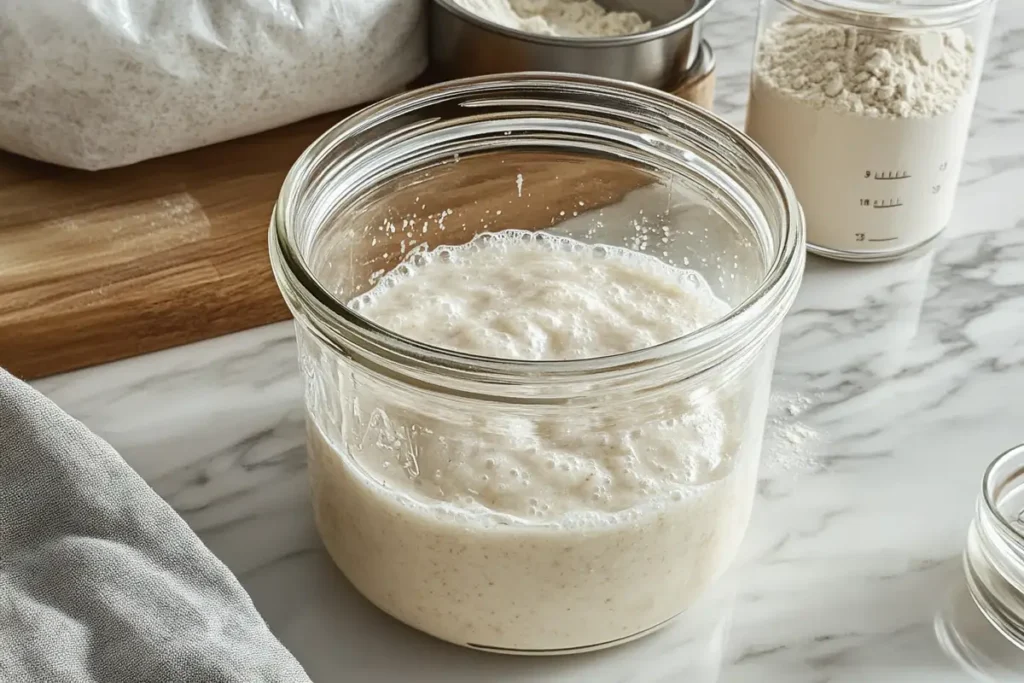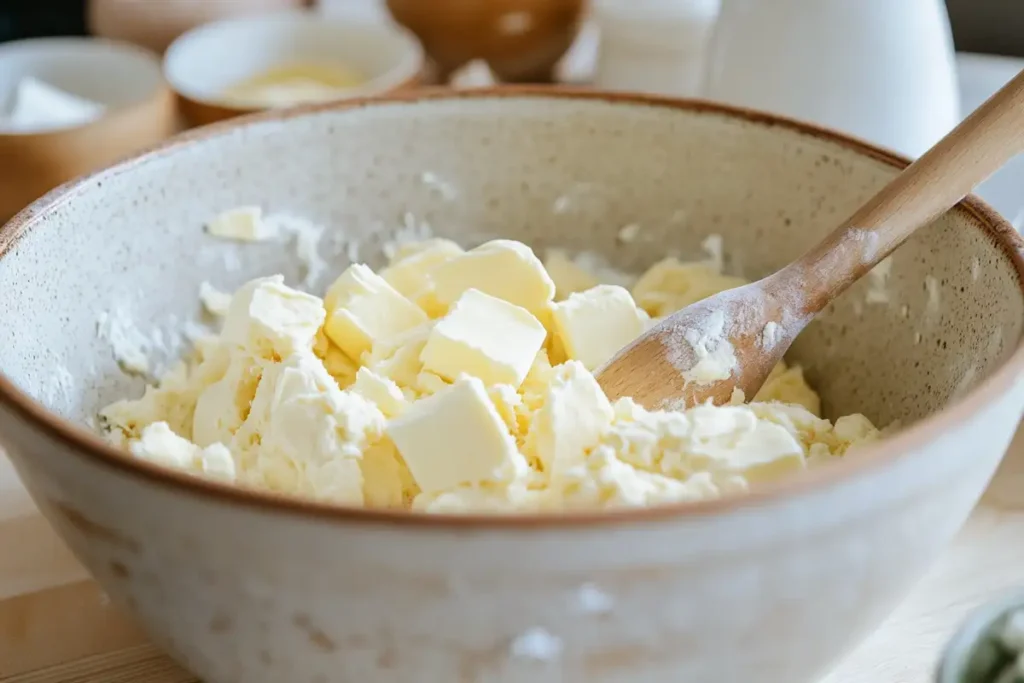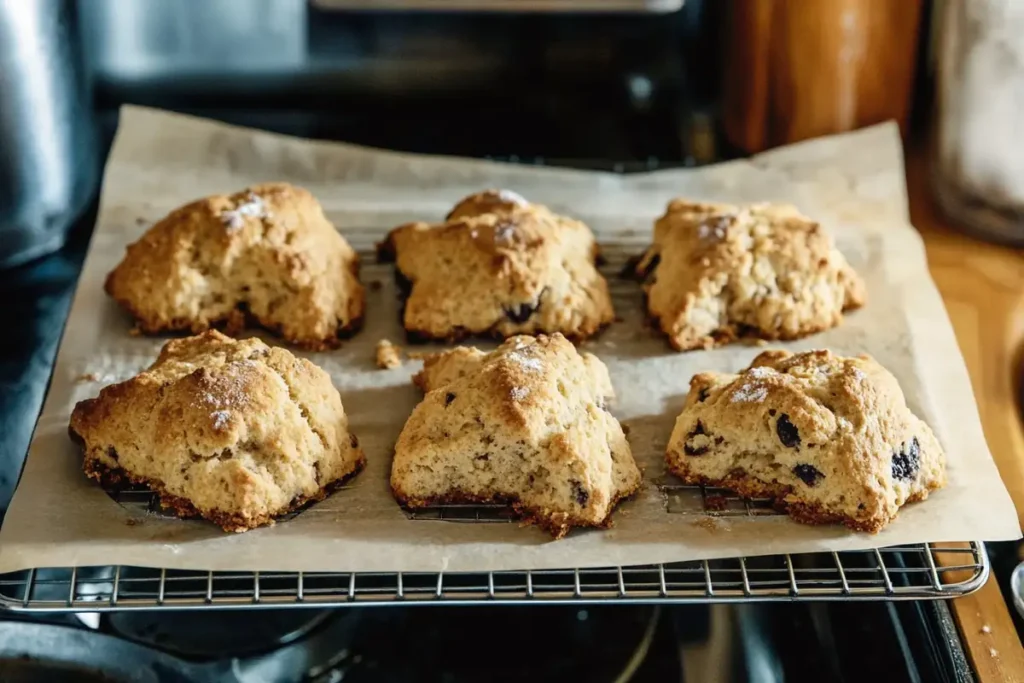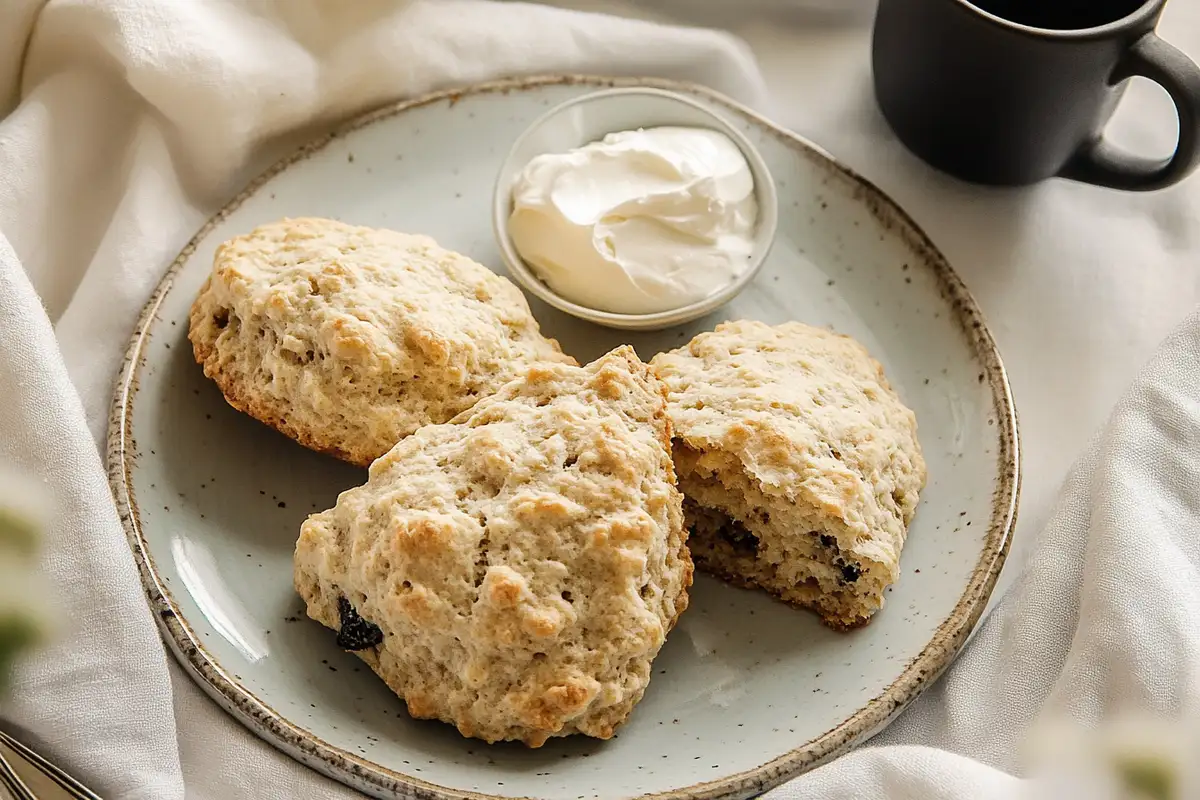Introduction and Overview of Sourdough Scones Recipe
Before diving into the world of sourdough scones, it’s essential to understand why this recipe has become a beloved choice for baking enthusiasts. Combining the tangy charm of sourdough discard with the rich, buttery essence of classic scones creates a delightful treat perfect for any occasion. From weekend brunches to cozy afternoon teas, sourdough scones offer versatility and exceptional flavor.
In this guide, we’ll explore the ins and outs of baking sourdough scones, covering everything from understanding the science behind sourdough to mastering the perfect bake. Whether you’re an experienced baker or just starting your sourdough journey, you’ll find valuable insights, helpful tips, and creative variations to make your scones shine. So, roll up your sleeves, preheat your oven, and embark on this delicious adventure!
Table of Contents
Brief History of Scones and Sourdough Baking
Scones originated in Scotland in the early 1500s, traditionally baked on griddles and served with clotted cream and jam. Fast forward to today, and they’ve become a staple in bakeries and homes worldwide.
On the other hand, Sourdough has roots dating back to ancient Egypt. Known for its unique fermentation process, it imparts a tangy flavor and airy texture to baked goods. Combining these two time-honored traditions creates a recipe steeped in history yet brimming with modern appeal.
Why You Should Try This Sourdough Scones Recipe Today
If you’ve been hesitant about baking with Sourdough, scones are the perfect place to start. They’re beginner-friendly, require minimal kneading, and always deliver fantastic results. Whether baking for family brunch, a fancy tea party, or just a solo treat-yourself moment, sourdough scones are guaranteed to impress.
For a deeper dive into the art of sourdough starter care, check out this insightful guide on How to Maintain sourdough starter.
Understanding Sourdough and Its Role in Baking
What is Sourdough, and Why Use it in Scones?
At its core, Sourdough is a fermented dough made from flour and water, relying on naturally occurring yeast and bacteria to create a rising effect. This fermentation process imparts a distinct tangy flavor and enhances the nutritional profile and digestibility of baked goods.
- Sourdough Starter vs. Sourdough Discard: A sourdough starter is an active, bubbly culture fed regularly with flour and water. On the other hand, Sourdough Discard refers to the portion of the starter removed before feeding. While it might seem wasteful to throw it away, sourdough Discard is packed with flavor and perfect for recipes like scones.
- The Science Behind Sourdough Fermentation: Fermentation breaks down gluten and phytic acid in flour, making baked goods gentler on the digestive system. This natural process also produces lactic acid, contributing to sourdough scones’ signature tangy flavor.
- How Sourdough Discard Adds Flavor to Scones: The slightly sour, tangy profile of sourdough Discard beautifully complements sweet and savory scone recipes. It’s like a hidden ingredient that adds complexity to every bite without overpowering the classic buttery richness of scones.
Baking with sourdough Discard is also environmentally friendly. Instead of discarding perfectly usable starters, bakers can repurpose them into delicious treats like pancakes, muffins, and—of course—scones.
Key Differences Between Traditional Scones and Sourdough Scones
While traditional scones are undeniably delightful, sourdough scones bring a unique edge.
- Texture Comparison: Traditional scones are known for their tender and crumbly texture. However, sourdough scones often have a slightly chewier crumb, thanks to the natural fermentation.
- Flavor Profiles: Traditional scones offer a straightforward buttery sweetness. In contrast, sourdough scones carry a subtle tang that enhances sweet and savory variations.
- Baking Process Variations: Regular scones rely on chemical leavening agents like baking powder, while sourdough scones benefit from natural yeast’s additional lift and structure in the sourdough starter.
This harmonious blend of science and flavor sets sourdough scones apart, making them a must-try for any baking enthusiast.
For those eager to dive deeper into the science behind scones, check out this informative resource: Understanding the Science of Scones.
Now that we’ve unraveled the magic of Sourdough, let’s move on to the key ingredients you’ll need to bake the perfect batch of sourdough scones.
Ingredients for the Perfect Sourdough Scones Recipe
Essential Ingredients for Sourdough Scones
Every exceptional batch of sourdough scones begins with carefully selected ingredients. Each component plays a vital role in achieving the perfect texture and flavor.
- Sourdough Starter or Discard: The star of the show! Sourdough Discard contributes a tangy flavor and light texture. An active starter can also be used, but discarding it tends to work better in scone recipes due to its consistency. The sourdough discard reduces waste and enhances the flavor and nutritional value of the scones, making them a healthier and more sustainable choice. Flour Options: While all-purpose flour is the go-to choice for most bakers, you can also experiment with whole wheat flour for added fiber and a nuttier taste. A mix of both often yields excellent results.
- Butter Quality and Its Importance: Always opt for unsalted, high-quality butter. The fat content in butter determines the richness and flakiness of the scones. Keep the butter cold until it’s incorporated into the dough for best results.
- Additional Ingredients:
- Milk or Cream: Adds moisture and richness.
- Eggs: Provide structure and contribute to the soft crumb.
- Sugar: Balances flavors and enhances browning.
- Baking Powder: Essential for lift and fluffiness.
When combined thoughtfully, these core ingredients create scones that are tender, flaky, and bursting with flavor.
Ingredient Substitutions and Variations
One of the best things about sourdough scones is their adaptability. Whether you have dietary restrictions or love experimenting in the kitchen, here are some excellent alternatives:
- Dairy-Free Alternatives: Replace milk or cream with almond, soy, or oat milk. Use plant-based butter to maintain richness.
- Gluten-Free Adjustments: Swap all-purpose flour with a gluten-free flour blend. Make sure the blend includes xanthan gum for binding.
- Flavor Add-Ins: Get creative with these additions:
- Fruits: Blueberries, cranberries, or diced apples.
- Herbs: Fresh rosemary, thyme, or chives.
- Chocolate Chips: A sweet indulgence perfect for brunch.
These variations ensure that sourdough scones can cater to every palate and dietary preference without compromising quality or flavor.
Step-by-Step Sourdough Scones Recipe Guide
Preparing Your Sourdough Starter or Discard

Before mixing and baking, preparing your sourdough starter or discarding it correctly is essential. The quality of your starter significantly impacts the texture and flavor of your sourdough scones.
- Maintaining Your Sourdough Starter: Ensure your starter is fed regularly. A healthy starter should be bubbly, slightly tangy, and smell pleasantly yeasty. A well-maintained starter is crucial for the success of your scones, as it provides the unique flavor and texture that only Sourdough can bring. Using Sourdough Discard: If you’re using sourdough Discard, ensure it’s not too old or overly acidic. Discarding from the last 1–2 days works best for baking.
- Consistency Matters: Your Discard should have a thick, pancake batter-like consistency. If it’s too watery, your dough may become sticky and difficult to handle.
If you’re new to maintaining a sourdough starter, refer to this helpful resource on How to Maintain Sourdough Starter.
Mixing the Dough

Mixing the dough is where the magic begins, and getting this step right is crucial for light, flaky scones.
- Start with Cold Ingredients: Ensure your butter, milk, and eggs are well-chilled. Cold ingredients help create flaky layers in the scones.
- Cutting in the Butter: Use a pastry cutter or your fingertips to rub the cold butter into the flour mixture until it resembles coarse breadcrumbs. This step prevents overly dense scones.
- Incorporating the Sourdough Discard: Gently fold the sourdough Discard and wet ingredients without overmixing. Overworking the dough can lead to tough scones.
- Dough Texture: The dough should be slightly sticky but still manageable. If it feels too wet, add a light dusting of flour.
The key is to mix just until everything comes together. A few flour streaks are perfectly fine!
Shaping and Cutting Scones
Shaping and cutting scones can seem simple, but small mistakes can affect the outcome.
- Rolling Out the Dough: Lightly flour your work surface and gently pat (not roll) the dough into a 1-inch thick disc. Avoid applying too much pressure.
- Cutting Scones Evenly: Use a sharp cutter or knife to cut the dough into wedges or rounds. Press straight down without twisting the cutter to ensure clean edges.
- Spacing on the Baking Tray: Place the scones on a parchment-lined baking sheet with at least 1 inch of space between them to allow even baking.
For added texture, brush the tops with a little cream or egg wash before baking.
Baking the Scones

Getting the bake right is the final step in achieving golden, flaky sourdough scones.
- Ideal Oven Temperature: Preheat your oven to 400°F (200°C). A hot oven ensures the scones rise quickly and develop a golden crust.
- Baking Time: Bake for 15–20 minutes or until the tops are golden brown and the scones feel firm to the touch.
- Cooling Time: Allow the scones to cool on a wire rack for at least 10 minutes before serving. This prevents them from becoming soggy.
Keep an eye on the oven—overbaking can dry out your scones while underbaking may leave them doughy in the center.
Troubleshooting Common Baking Issues
Even experienced bakers encounter a hiccup or two. Here’s how to address common sourdough scone problems:
- Flat Scones: This often results from warm butter or overmixing the dough. Ensure your butter stays cold and avoid excessive kneading.
- Dry or Crumbly Texture: Too much flour or overbaking can lead to dryness. Follow the measurements carefully, and don’t extend the baking time unnecessarily.
- Scones Spread Too Much: The dough was likely too wet, or the oven temperature was too low. Adjust the consistency and preheat the oven adequately.
Tips and Tricks for Perfect Sourdough Scones
Pro Tips for Light and Fluffy Sourdough Scones
Even seasoned bakers know that scones can be a little finicky. Follow these expert tips for consistently perfect results:
- Chilling the Dough Before Baking: Place your scones in the refrigerator for at least 15 minutes after shaping them. Chilled dough holds its shape better in the oven and rises evenly.
- Avoid Overmixing: Gently mix the dough until just combined. Overworking the dough develops too much gluten, resulting in dense scones.
- Proper Storage Methods: Store freshly baked scones in an airtight container at room temperature for up to 2 days. For longer storage, freeze them and reheat them when needed.
Sometimes, the simplest adjustments yield the most noticeable improvements.
Common Mistakes to Avoid When Making Sourdough Scones
Mistakes happen, but they’re also preventable. Here are common pitfalls to sidestep:
- Overhandling the Dough: Excessive kneading or rolling can ruin the tender crumb of your scones. Handle the dough as little as possible.
- Incorrect Ingredient Measurements: Baking is a science! Use precise measurements, especially for flour and butter.
- Skipping the Chilling Step: Chilling the dough helps maintain structure and flakiness during baking.
Sourdough Scones Recipe Variations
Sweet and Savory Sourdough Scones Recipes
One of the most exciting aspects of baking sourdough scones is their incredible versatility. Whether you have a sweet tooth or prefer something savory, there’s a sourdough scone recipe for every craving.
- Sweet Options:
- Berry Scones: Add fresh or frozen berries like blueberries, raspberries, or strawberries to your dough for a juicy burst of sweetness.
- Chocolate Scones: Mix in chocolate chips or chunks for an indulgent treat perfect with afternoon tea.
- Lemon Glaze Scones: Drizzle a tangy lemon glaze over warm scones for a refreshing finish.
- Savory Options:
- Cheese and Herb Scones: Sharp cheddar cheese combined with fresh herbs like rosemary or thyme creates a delightful, savory snack.
- Garlic and Parmesan Scones: Add minced garlic and grated parmesan for a rich, aromatic twist.
- Bacon and Chive Scones: Crispy bacon bits and chopped chives make these scones a brunch favorite.
These variations demonstrate the adaptability of sourdough scones, offering flavors that can suit breakfast, brunch, or even a light dinner.
Seasonal and Holiday Scone Ideas
Why not let the seasons inspire your baking? Here are some festive sourdough scone ideas to add a special touch to any occasion:
- Pumpkin Spice Scones for Fall: Infuse your dough with pumpkin puree, cinnamon, nutmeg, and cloves for a cozy autumnal treat. A dusting of cinnamon sugar on top is the perfect finishing touch.
- Cranberry Scones for Winter: Add fresh or dried cranberries and a hint of orange zest for a festive holiday bake that pairs beautifully with mulled wine or spiced tea.
- Spring Lemon Lavender Scones: Combine fresh lemon zest and culinary lavender for a light, floral springtime flavor.
Serving and Pairing Sourdough Scones
Best Ways to Serve Sourdough Scones

Sourdough scones are incredibly versatile and can be served in numerous delicious ways. The right accompaniments can elevate these baked delights to a whole new level.
- Classic Pairings: Freshly baked scones are best enjoyed with classic toppings like clotted cream, butter, and fruit preserves. A dollop of homemade strawberry jam or lemon curd works wonders.
- Savory Additions: For savory scones, consider serving them with cream cheese spreads, herbed butter, or even slices of sharp cheddar cheese.
- Warm or Room Temperature: Scones taste best when slightly warm. If reheating, a quick stint in the oven at 350°F (175°C) for 5 minutes will do the trick.
Whether served at a brunch table or as an afternoon snack, these accompaniments make every bite memorable.
Beverage Pairings for Sourdough Scones
What’s a scone without the perfect drink? Pairing beverages with sourdough scones enhances flavor and creates a delightful eating experience.
- For Sweet Scones: A hot cup of English Breakfast Tea or a creamy latte complements sweet scones beautifully.
- For Savory Scones: Pair savory scones with aromatic Earl Grey Tea or a robust black coffee.
- Special Occasions: For an extra indulgent treat, serve sweet scones with sparkling beverages like Prosecco or Mimosa.
The right pairing can transform a simple scone moment into an experience worth savoring.
Storing and Freezing Sourdough Scones
How to Store Freshly Baked Scones
Proper storage is essential to keep your sourdough scones fresh, soft, and flavorful. Unlike other baked goods, scones have a delicate texture that can dry out quickly if not stored correctly.
- Room Temperature Storage: Place the cooled scones in an airtight container lined with a paper towel. The paper towel helps absorb any excess moisture, preventing sogginess. Store them at room temperature for up to 2 days.
- Refrigeration (Not Recommended): Storing scones in the fridge can make them lose their soft, tender texture. Only refrigerate if your scones contain perishable ingredients like cream cheese or fresh fruit.
- Best Practice Tip: Allow your scones to cool completely before storing them. Storing warm scones can trap steam, resulting in a mushy texture.
Freezing and Reheating Sourdough Scones
Freezing is an excellent way to preserve your sourdough scones for longer periods without compromising their quality.
- Step-by-Step Freezing Guide:
- Let the scones cool completely after baking.
- Wrap each scone individually in plastic wrap.
- Place the wrapped scones in a ziplock freezer bag or an airtight container.
- Label it with the date and freeze it for up to 3 months.
- Best Methods for Reheating:
- Remove the scones from the freezer and let them thaw at room temperature.
- For freshly baked texture, reheat in a preheated oven at 350°F (175°C) for 5–10 minutes.
- Alternatively, use a toaster oven for a quicker reheating option.
Proper storage and reheating ensure that every bite of your sourdough scones tastes as delicious as the day they were baked.
Let’s answer some frequently asked questions about sourdough scones to help you perfect your baking game.
FAQs About Sourdough Scones Recipe
What is the secret of making good scones?
The key to perfect scones lies in the details:
Use Cold Ingredients: Cold butter and milk create flakier scones.
Don’t Overmix the Dough: Overworking the dough develops gluten, resulting in dense scones.
Chill Before Baking: Chilling the shaped scones for at least 15 minutes helps them retain their shape.
Preheat Your Oven: Ensure the oven is fully preheated to 400°F (200°C) for an initial burst of heat, which helps them rise beautifully.
What not to do with Sourdough?
When using sourdough starter or discard in baking, avoid these common mistakes:
Using an Unhealthy Starter: If your starter smells off, has mold, or hasn’t been fed in weeks, it’s best to discard it entirely.
Neglecting Proper Measurements: Eyeballing quantities can ruin the dough’s consistency.
Ignoring Fermentation Time: Rushing the sourdough process can compromise flavor and texture.
Why use Sourdough discard in baking?
Using sourdough Discard isn’t just about reducing waste—it offers several benefits:
Flavor Enhancement: The natural tanginess of Sourdough adds depth to baked goods like scones.
Improved Texture: Sourdough discard contributes to a tender and slightly chewy crumb.
Nutritional Benefits: The fermentation process makes nutrients in the flour more accessible and easier to digest.
Waste Reduction: Instead of discarding excess starter, you’re repurposing it into something delicious.
What are the mistakes when making scones?
Scones might seem simple, but even seasoned bakers stumble over these common pitfalls:
Overmixing the Dough: This results in tough, dense scones.
Skipping the Chilling Step: Warm dough leads to scones that spread and lose their shape in the oven.
Incorrect Oven Temperature: Too low, and your scones won’t rise. Too high, and they might burn on the outside while staying raw inside.
Neglecting Proper Measuring: Baking requires precision, especially in flour and butter.

